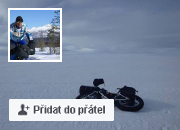Radio Prague
Jan Kopka – winner of the Iditarod Trail Invitational, the world’s toughest adventure race
[25-04-2007] By Jan Velinger

Jan Kopka
photo: www.ivelo.cz
Many listeners will probably have heard of the famous Iditarod sled dog race run in Alaska since the 1970s, recalling images of huskies pulling mushers across the frozen wastes. But they may be less familiar with the Iditarod Trail Invitational, a similar adventure race in which roughly 1,800 kilometres are crossed not using sled dogs but by going on foot, using cross-country skis, or mountain bikes. This year the mountain bike category was won by Czech rider Jan Kopka, a former road racer turned mountain biker with a passion for the extreme. At 43, Kopka won the toughest race in the world after 23 days en route. Once again: 1,800 kilometres on bike, across Alaska, in winter. If you find it difficult to get your head around that, keep listening. Jan Kopka told me more about the race this week on the phone from the US.
„Originally I was a road biker and when I was almost 30 I finished my career. At that time mountain biking started and because I have the soul or heart of a racer I took it up and began racing just for fun or for a hobby. But the results were quite good, so I began looking for races that were different from regular races because I’d already done a lot of classic races in my life and they were all very similar. My first extreme races weren’t as tough as the ones that I do today, but slowly I started to move to more extreme races like Iditarod. Iditarod is probably the most extreme race on the planet.“

photo: www.jankopka.cz
Not surprisingly, the field of racers taking part in the Invitational is relatively small – only seasoned and experienced riders really dare take part. This year around thirty racers on foot, skis, as well as bike took part. Iditarod is about strong physical endurance and mental strength, as well as the ability to calculate ever-changing risks and conditions. Contenders have to be ready to put up with the worst:
It’s many things together. You have to be good on the bike but you also have to be able to survive similar conditions like climbers or mountaineers. Maybe if I can compare some days just this year: some days I was able to do 90 miles a day and others I wasn’t able to move at all or just ten miles with great effort and I was absolutely dead! The dogsleds, by comparison, can move quite steadily: it’s not that big difference in their pace if the conditions are good or bad. They move more steadily. Bikers, you know, some days they can’t move anywhere. Because of deep snow, or a thunderstorm or ground blizzard or blizzard, or because there are areas where there was just tundra and we couldn’t move there. There was no trail; there was nothing.“
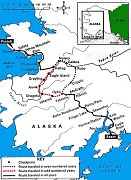
Source:
Alaskaultrasport.com
At such moments, riders like Jan Kopka are left little choice but to either hunker down or carry their bikes, along with rations as well as all their equipment taken from the start: protective clothing, a gas stove, tools, utensils, sleeping bags or tents. The mountain bikes, equipped with super fat tires to better handle the trail, weigh thirty kilos alone.
„I used an aluminium frame but this year many of the racers used steel frames or some also used titanium. The biggest requirement is for the bike to be as light as possible.“
According to Kopka, a good part of the route this year saw hard-packed snow but was sometimes also snow-free in the Alaskan interior. While the going was never easy, the experience was unforgettable:
„Usually you could see the night sky, even if you travelled: we usually travelled in daytime but also a bit at night. But if you sleep in the open air you can see the stars above or even the Northern Lights. It’s very nice. But usually you are so tired that you sleep within seconds.“

photo: www.ivelo.cz
„Areas where we were there were beautiful mountains and usually very deep frost. But a lot of blue sky days with sunshine. If you take pictures on these beautiful days it looks very romantic if you view the pictures in a warm room. But even on such beautiful days it was sometimes -40 degrees Celsius and those are temperatures that just paralyse you. I think everybody had frostbite but it depends on the grade of frostbite: I got just to the second degree: that means I had blisters and white places on the fingers and face. But some riders got black frostbite and it’s very dangerous to continue with this.“
The fact that the Iditarod Trail Invitational is an „unsupported“ race also adds to the risk: with the exception of food dropped-off by organisers at certain points, you’re really on your own. There are only check-points for the first five hundred kilometres and after that riders call in when they can, from villages along the way, just to let organisers know they are still in the race and that they’re „okay“.
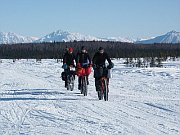
Photo: www.ivelo.cz
„You have a chance to speak with people also in villages, usually native villages or white people living there. And you should do it to learn about conditions ahead and the weather forecast or just to plan what to do! Sometimes you also meet hunters or travellers or just locals travelling between villages. So there are occasions where you have a chance to meet somebody on the trail.“
If something bad does happen, you experience a sprain, or break, or mechanical failure, there is one major rule:
„The first rule, if something happens, is not to move from that place. The first rule: don’t leave the trail because nobody will find you. You can just stay on the trail and hope that somebody will find you. You know, there’s a chance that somebody will because there are other competitors but it could happen that conditions are really bad and that there is nobody behind you. That they are in the last village waiting for conditions to clear.“

During the extreme race the days gradually melt into one. Jan Kopka told me there was occasionally a chance for camaraderie, when you’d meet other racers on the trail and share information. But for the most he was on his own, riding at his own pace. Day after day he inched a little closer to the final destination, eventually realising he had a real shot. The final destination Nome was now reachable but Jan Kopka did not want to think just how close. Another excerpt from the interview:
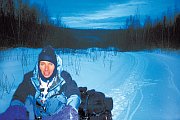
Jan Kopka
photo: www.ivelo.cz
„I travelled alone but days before I was with American rider Joseph Dundee so I knew that he was strong and that he was behind me and that he would get to Nome too. I knew that I was the first on the trail but I didn’t want to think that I can win: there are a lot of things that could stop you. In this race you never know what can happen in the next second or minute: it could be injury, it could be a mechanical problem. A lot of problems are ‚unsolvable‘ on the trail. An example was twenty miles before the finish line my left crank fell off. I just moved by pedalling with one leg. But it was possible only because I was already close to the end of the race. If this had happened earlier or several days before I would have been finished! Maybe I would have even had problems getting to a safe place.“

photo: www.jankopka.cz
JV: I just want to make sure that I heard you correctly: did you say twenty?!
„Twenty miles.“
JV: That still a lot it seems to me! …
„Yeah, yeah, it’s still a lot but you know I thought I was at the finish line: compared to 1,100 miles, twenty miles is nothing. You can push it, you can push it. It’s twenty miles: you can push it and get to the finish line.“
JV: So you crossed the line with basically one functioning pedal because the other crank was gone.
„Yeah, yeah, yeah.“
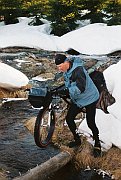
Photo:
www.ivelo.cz
Only Jan and one other MTB rider – American Joseph Dundee – completed the full course. This is how the Czech rider marked the final day:
„In that time when I was finishing, many mushers were also finishing. I was alone there: there was nobody from our race. It’s an ‚unsupported‘ race so when I got there I just called from Nome that I am there and they marked the time and put it up on the website and for me the race was over. But when I was there Iditarod – the sled dog race – a very big race had a lot of volunteers and mushers there and fans and I was invited by mushers to have a beer with them. So I celebrated the first night with two beers with the mushers at a local bar. They were really nice and… it was good.“
Jan Kopka has achieved something most of us would never dare even imagine. But it is interesting to picture in one’s mind’s eye: cycling across Alaska in deep winter. Cycling not just to win but at times simply to survive.


















